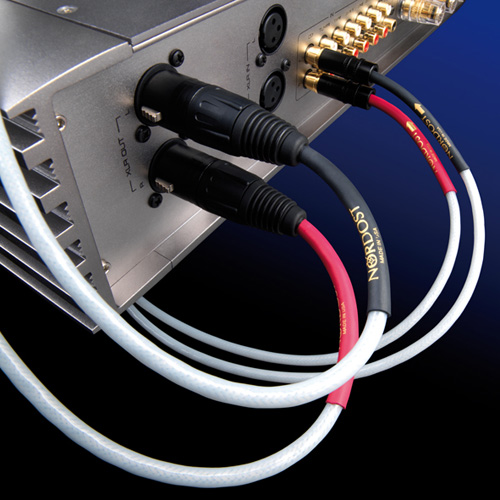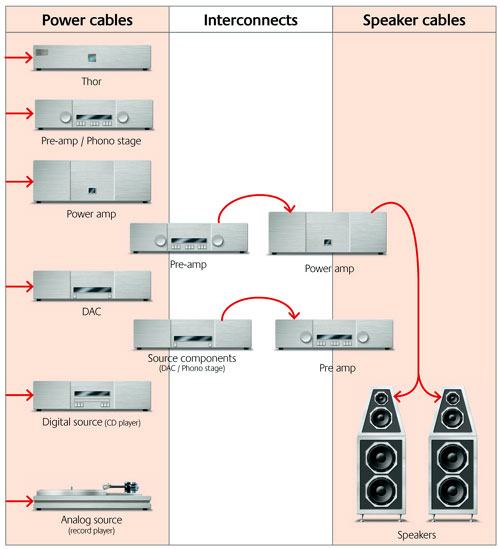Cables as Components
If it’s so obvious, why has it taken so long to realize that this is the case? Because for the most part customers, reviewers and even audio shops don’t actually have sufficient demonstration cables on hand to wire a complete system from one end to the other. Instead, they have one each of everything they sell. The good news is that even in a simple four-box system (CD player, integrated amp and speakers) this rule doesn’t just apply, it can easily be demonstrated. All you need is two sets of cables -- two power cords, one pair of interconnects and a pair of speaker cables -- one all from the same source/range, the other a mix-and-match collection from four different suppliers. Listen to the system with the mix-and- match cables, then change everything at once to the matched set. Result? You’ll hear a huge improvement in overall musical coherence, rhythmic integrity, intelligibility and musical drama. The performance makes more sense, while the band sounds like a better band, its members like better musicians. What’s more, the matched set of cables (or "loom") will still outperform a cocktail of competitors costing considerably more. And the more boxes you add to the system, the greater that difference becomes -- so the bigger and more complex your system, the more important it is to use a coherent cable loom if you are going to realize its performance potential. How to create a coherent cable loom
What this means in product terms is that you might opt for silver cables or silver-plated copper; Teflon insulation, an air-space design or something unusual like Kapton; your cables might employ networks, or they might feature lightweight, minimalist connectors. What is important is that all of the cables in your system, from power cord to biwire jumpers (if you use them), should share the same materials and philosophy. That’s why choosing cables from the same manufacturer is a good place to start, but it is no guarantee of success. Some manufacturers are more aware of this than others; some have more control over what goes into their wires and how they’re put together. What you are looking for is consistency. The good news is that not only are you looking at a potentially serious upgrade in system performance, but achieving it just got a whole lot easier too. Now, instead of selecting a specific cable for each and every point in your system, you are choosing one range over another. What if your dealer can’t wire your system end to end with three different cable brands? Make a provisional choice on the basis of the simple system you started with. That will easily show you the family characteristics of different cable brands. Once you’ve narrowed down, any serious dealer/manufacturer is going to loan the demo cables needed to wire your whole system. Why wouldn’t they? Well, okay, there’s always someone with 60' speaker cables and a triamped system, but under more normal circumstances a little compromise will generally solve most problems. And once you have decided which range you prefer, specifying the cabling for your system as a whole is child’s play. All you have to do is follow the rest of the rules. |

 opular wisdom would have it
that you need to match each part of your system with a specifically chosen cable -- bright
CD player with warm, rounded interconnects, and so on. But extensive controlled listening
with complete cable sets quickly demonstrates the fallacy of this. In fact, mixing and
matching cables throughout a system is one of the worst things you can do. Instead you
should aim to use the same cabling right through your setup.
opular wisdom would have it
that you need to match each part of your system with a specifically chosen cable -- bright
CD player with warm, rounded interconnects, and so on. But extensive controlled listening
with complete cable sets quickly demonstrates the fallacy of this. In fact, mixing and
matching cables throughout a system is one of the worst things you can do. Instead you
should aim to use the same cabling right through your setup. hen we say, "use the
same cables right through the system," we are talking about more than simply buying
everything from the same manufacturer -- although that’s generally a good place to
start. In practice, each cable in a system will often benefit from having its topology and
electrical characteristics tuned to purpose (although Crystal Cable, for one, makes a
point of utilizing identical conductors throughout each family of cables in their range,
so that the power cord uses three of the same conductors as in the interconnect). What we
mean by the phrase "use the same cables" is that the cables you use should all
employ the same conductor and insulation materials and should be designed and terminated
with a common philosophy.
hen we say, "use the
same cables right through the system," we are talking about more than simply buying
everything from the same manufacturer -- although that’s generally a good place to
start. In practice, each cable in a system will often benefit from having its topology and
electrical characteristics tuned to purpose (although Crystal Cable, for one, makes a
point of utilizing identical conductors throughout each family of cables in their range,
so that the power cord uses three of the same conductors as in the interconnect). What we
mean by the phrase "use the same cables" is that the cables you use should all
employ the same conductor and insulation materials and should be designed and terminated
with a common philosophy.